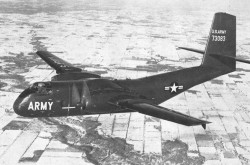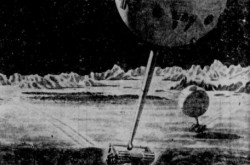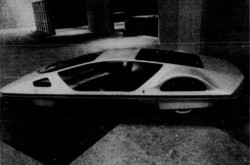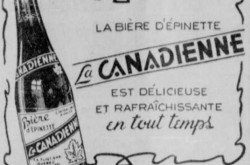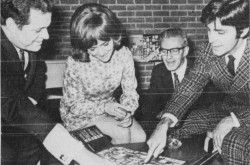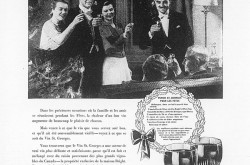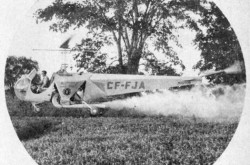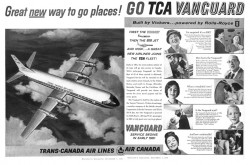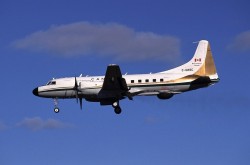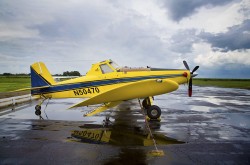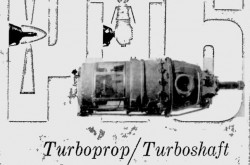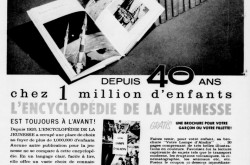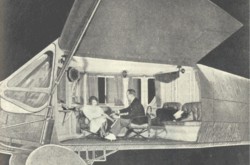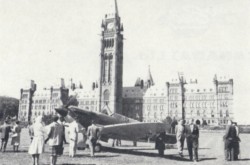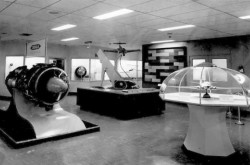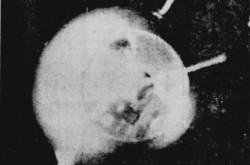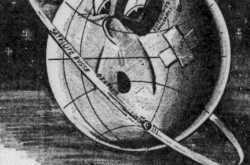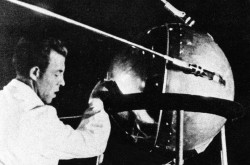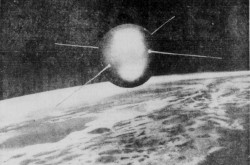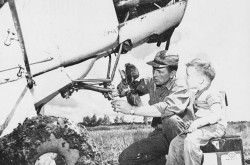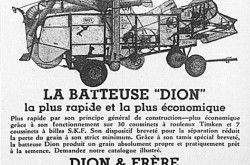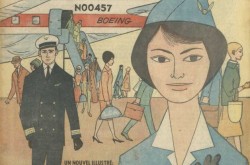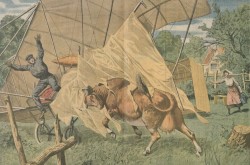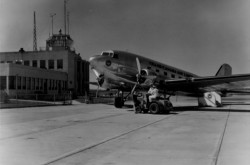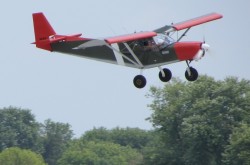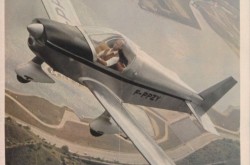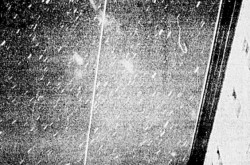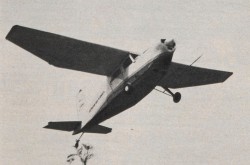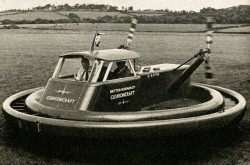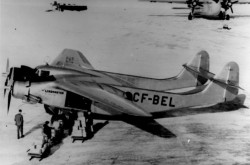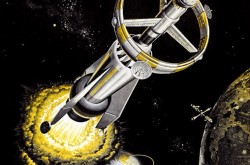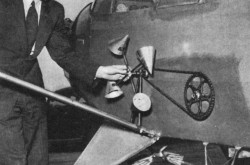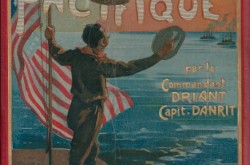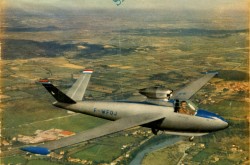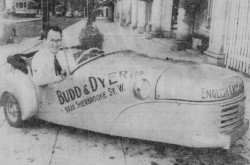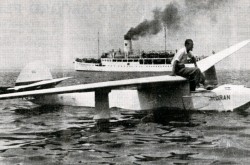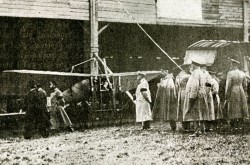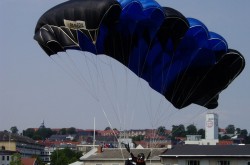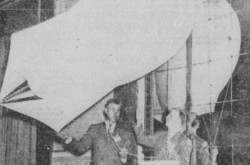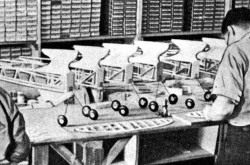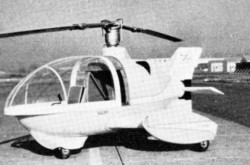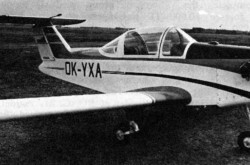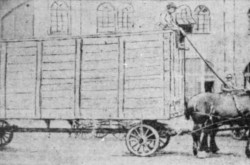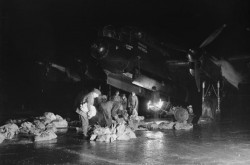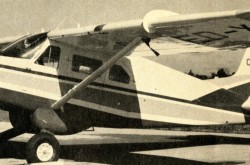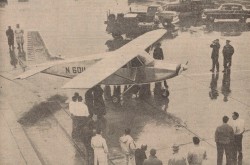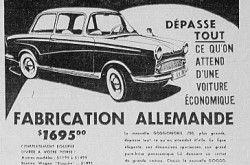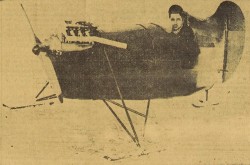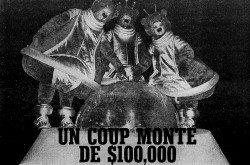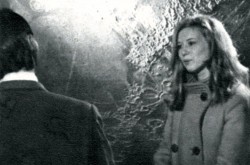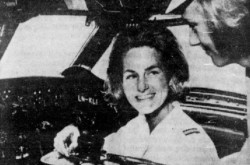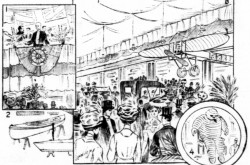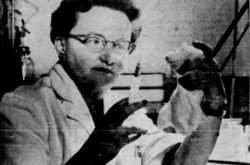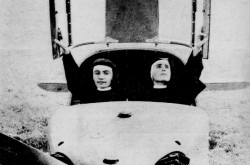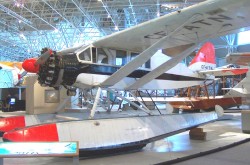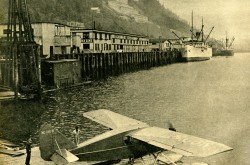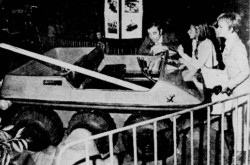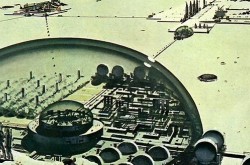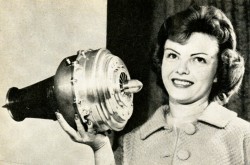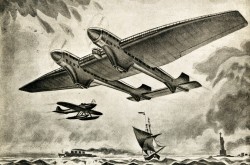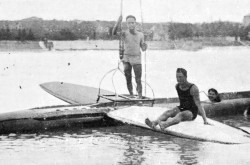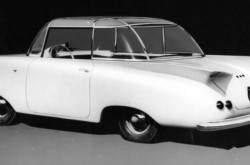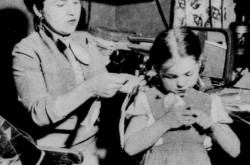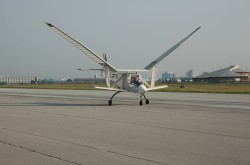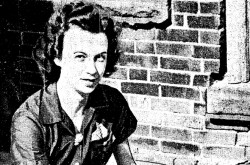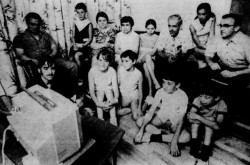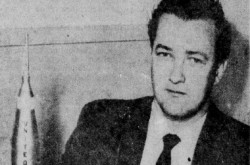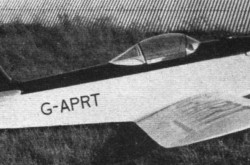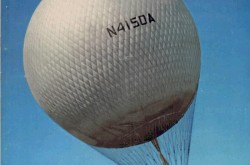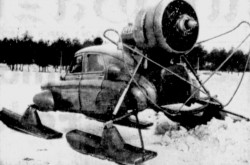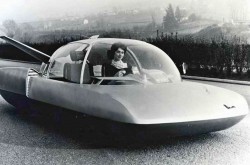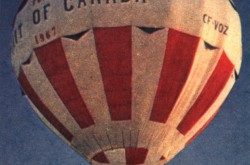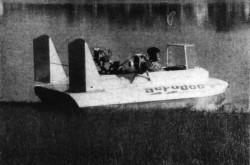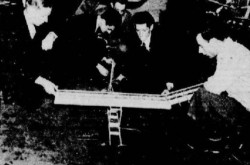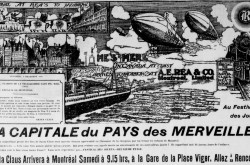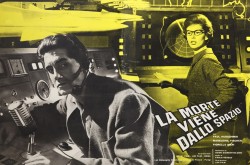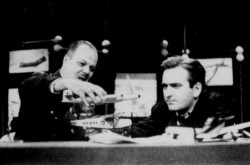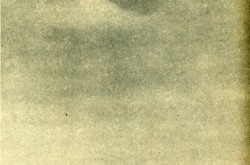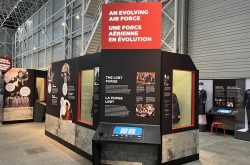You say Mustang, I say Gnatsum: Christopher Barnard Falconar and another giant leap for homebuilding in Canada

Hi, hello. How are you on this November day? Having stumbled (Ouch. Sorry.) on the photograph above while I was exploring the November 1969 issue of the American magazine Air Progress, I had the idea to write (talk?) to you about a very important personality in the Canadian homebuilder / amateur aircraft making community who lived in Edmonton, Alberta.
An avid model maker during his youth, Christopher Barnard “Chris” Falconar was born in 1927. He began his career in aeronautics towards the end of the Second World War, and / or a little later, in Québec, at Noorduyn Aviation Limited of Cartierville and in a Montréal region plant of Canadian Car and Foundry Company Limited – 2 firms mentioned in January and May 2019 issues, on the one hand, and in November 2018 and January 2019 issues, on the other hand, of our blog / bulletin / thingee.
Falconar was apparently one of the founding members of the McGill University Gliding Club, in Montréal. Around 1953, he completed his training, apparently in aircraft maintenance, at the Provincial Institute of Technology and Art (PITA) in Calgary, Alberta.
Interestingly, at least for moi / me, passionate about digression as I am, this institution seemed to be the first Canadian technical school offering training in aerotechnics. PITA, today’s Alberta College of Art + Design, offered evening classes at the Calgary Aero Club as early as 1928. A 2-year course in aviation mechanics was available from 1930. PITA also offered a 2 year aircraft maintenance engineer / technician course during and after the Second World War. The version available after September 1945, however, which dealt with both airframes and engines, had been extensively modified to take into account the technological changes that took place during the conflict, but back to our story.
Once graduated, Falconar worked (in Western Canada?) for Spartan Air Services Limited of Ottawa, Ontario, the largest aerial survey company in Canada and one of the largest in the world. Moving to Edmonton, this bilingual glider pilot was one of the founding members of the Edmonton Soaring Club and of a chapter of the Experimental Aircraft Association (EAA) – the world’s largest light aviation / homebuilding organisation, based in the United States, which played a crucial role in the evolution of homebuilding in North America. In that regard, Falconar was said to be the father of the EAA in Canada – and one of the fathers of the homebuilding movement in Canada after the Second World War. As we both know, the EAA was mentioned in September 2017, October 2017 and June 2019 issues of our blog / bulletin / thingee.
Falconar founded Falconar Aircraft Maintenance [Incorporated? Limited? Registered?] around 1956-57. Within a few years, this small aircraft maintenance company became one of the largest, if not the largest distributor of sets of plans for homebuilt aircraft in Canada. Over the months, Falconar Aircraft Maintenance signed distribution agreements with French companies such as the Société des avions Jodel and Avions Claude Piel, as well as with a British company, Phoenix Aircraft Limited.
Between 1959 and 1965, Falconar Aircraft Limited, a company name adopted no later than 1964, sold nearly 1 500 sets of plans for some types of aircraft to homebuilders in Canada, the United States and some 40 other countries. Georges Jacquemin, a contributor to the well-known monthly magazine Canadian Aviation and a former engineer at A.V. Roe Aircraft Limited (Avro) of Malton, Ontario, translated and converted the plans for many of these aircraft, from metric to Imperial measurements. I hear (read?) that Darth Vador acknowledged his loyalty to the Empire, but I digress.
Falconar’s company also delivered parts and kits to Canadian, American and other buyers. It should be noted that many Canadian homebuilders claimed to have learned the basics of homebuilding by reading Jacquemin’s series of articles published in Canadian Aviation in the early 1960s.
And yes, my reading friend, the Canadian aircraft manufacturer Avro, a well-known firm if there was one, was mentioned in some issues of our blog / bulletin / thingee since March 2018.
The Canadian chapter of the EAA mentioned earlier, Chapter 30, was the first in Canada to be established by the EAA. Officially founded in March 1957, it was in fact the first foreign chapter of the organisation. One of its members during the 1960s lived in Yellowknife, Northwest Territories. He travelled back and forth between his home and Edmonton to attend chapter meetings – a journey of nearly 1 000 kilometres (620 miles) in each direction. This unrivaled pilot used the Loving / Wayne WR-1 Love he had built. This fast / racing single-seater was certainly noteworthy because its designer, aeronautical engineer and pilot Neal Vernon Loving, was an African-American who had lost both of his legs. Another chapter member, James “Jack” Warner, crossed Canada on at least 2 occasions in the 1970s.
Around 1958, Falconar Aircraft Maintenance signed an agreement with the Réseau du sport de l’air, the national association of French homebuilders. It was therefore able to sell English and French versions of the sets of conversion plans of Volkswagen horizontally opposed air-cooled engines, as well as parts, to Canadian homebuilders. The aforementioned Jacquemin translated the manuals and modified the original plans. In fact, the company may have performed a number of engine conversions in its workshops.
Falconar also modified the plans of another aircraft of French origin, the Maranda Super Loisir, which became the Falconar AMF-14 Super Maranda. Around 1959-60, Maranda Aircraft Company Limited signed an agreement with Falconar Aircraft Maintenance to allow it to manufacture kits of the Super Loisir and of its predecessor, the Loisir.
Maranda Aircraft was one of the first, if not the first Canadian aircraft manufacturer specialising in the design and production of aircraft and kits for homebuilders. This company founded in Montréal, by Bernard C. “Bernie” Maranda, acquired around 1957 the global production rights of 2 French aircraft, the Adam RA-14 Loisir light / private 2-seater and the RA-17 single-seat agricultural airplane, developed by the Établissements aéronautiques Roger Adam. The small Québec company marketed them under new Loisir type designations. A Super Loisir made its appearance in 1961. Thirty or so of these aircraft flew over the years. Maranda Aircraft subsequently acquired the production rights for a few additional aircraft. This firm disappeared at an indeterminate date.
Active between 1946 and 1955, the Établissements aéronautiques Roger Adam disappeared at an equally indeterminate date. The Loisir seemed to be the only aircraft of this now well-forgotten stable to have known a tiny bit of success, but back to our story.
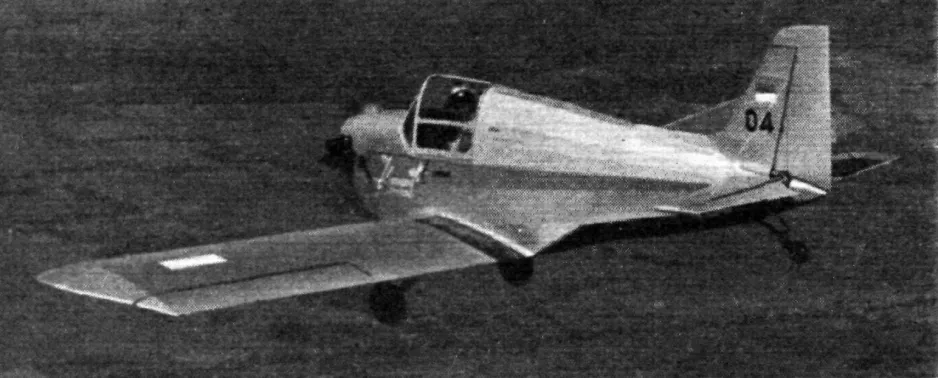
The prototype of the Lembaga Persiapan Industri Penerbangan NU-25 Kunang, or Kunang 25. Anon., “Asia’s Aircraft Industry.” Flight International, 26 July 1962, 136.
Falconar Aircraft Maintenance’s expertise earned it a somewhat unusual contract. The department of the republic of Indonesia air force, a service known as the Tentara Nasional Indonesia Angkata Udara, asked it to develop a conversion of the latest version of the Volkswagen engine, intended for a light / private single-seater designed by an institute for the preparation of an aircraft industry, the Lembaga Persiapan Industri Penerbangan (LAPIP), and intended for Indonesian flying clubs. Work on this NU-25 Kunang, or Kunang 25, had begun in 1957; a prototype flew in 1958.
The West German state-owned company Volkswagen Gesellschaft mit beschränkter Haftung having pretty much refused to cooperate, Falconar Aircraft Maintenance was forced to go it alone. It completed the first examples of the converted engine in the spring of 1964. Once tests were completed, the company shipped some engines to Indonesia. LAPIP, renamed Lembaga Industri Penerbangan Nurtanio, in 1966, apparently produced some examples of a more powerful version of its light / private aircraft tested in October 1963, the NU-35 Kunang / Super Kunang, or Kunang / Super Kunang 35. This writer was however unable to confirm whether or not Canadian engines were mounted on these aircraft. Indeed, I can’t even confirm that the NU-25 and NU-35 went beyond the prototype stage.
Considered ideal for many types of homebuilt aircraft, the Falconar O-90 Little Demon, a designation apparently adopted after the Indonesian contract was completed, was manufactured in small numbers in the 1960s. Falconar Aircraft Maintenance exported some to the United States. Production of the Little Demon apparently resumed around 1984 and continued for an indefinite period.
Falconar Aircraft Maintenance also manufactured a number of wooden fixed pitch propellers during the 1960s. Designed to be mounted on modified Volkswagen engines, these propellers were purchased by Canadian homebuilders.
Falconar Aircraft Maintenance / Falconar Aircraft also sold sets of plans of many homebuilt aircraft during the 1960s and 1970s. Its founding president somewhat modified the plans for 2 aircraft designed by the Société des avions Jodel, the D-9 Bébé and D-11 Club. His company sold plans and kits of the 4 slightly larger and easier to make aircraft thus created. Falconar Aircraft Maintenance / Falconar Aircraft also sold sets of plans and kits of at least 3 French Pou du Ciel type aircraft designed by Henri Mignet, a gentleman mentioned in a January 2018 issue of our blog / bulletin / thingee. Business was so good that the company moved into a new building in the spring of 1967.
Falconar Aircraft began working on 2 even more interesting projects even before the mid-1960s. One of these concerned a 2-seat single-engine amphibian, the Teal. Aware of the interest inspired by an American aircraft of this type, the first amphibian intended for homebuilders in fact, the Volmer Jensen VJ-22 Sportsman, Falconar aimed to develop an amphibian better suited to Canada’s geographical conditions. In fact, the synthetic fabric which covered the structure of Teal, known as Lincoln fabric, was developed with the help of Falconar Aircraft. The highly durable synthetic finish which covered everything, known as Plastithane or HIPEC, originated from work done by Falconar Aircraft and Plastiglo Industries Limited of Edmonton. Impressed by Lincoln fabric and Plastithane / HIPEC, the Canadian Department of Transport quickly approved these products.
The first Teal, manufactured by 2 homebuilders, “Bud” Gillis and Donald “Don” Riemer, respectively owners of a sawing service and a plumbing and heating company, flew in December 1967, in Kamloops, British Columbia. Falconar Aircraft sold both sets of plans and kits of this aircraft. The company investigated some factory manufacturing projects, including at least one in the United States. None of them led to a series production program for the Teal. Metal or plastic versions proposed around 1965-66 were not produced. This being said (typed?), Falconar Aircraft sold more than 200 sets of plans. Only the Flying Spaghetti Monster knows how many of these projects were completed. A single Teal was still in the Canadian civil aircraft registry in 2019. My illustrious employer, the Canada Aviation and Space Museum, in Ottawa, could consider the possibility of thinking about acquiring this aircraft. Just sayin’.
With your permission, yours truly would like to digress a bit on the Sportsman, an aircraft quite well adapted to Canada’s geography. The very first copy of this American aircraft designed around 1957 by Volmer Sofus Jensen flew in December 1958. It was then known under the nickname of Chubasco. Having failed to produce it commercially, Jensen began to sell sets of plans of this excellent aircraft.
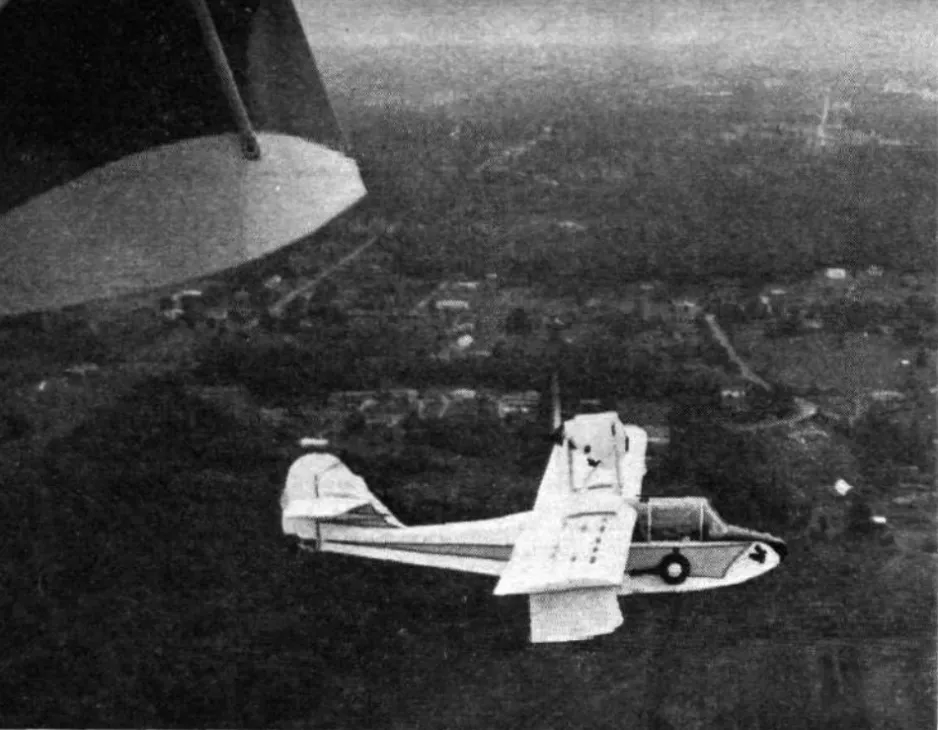
The Volmer Jensen VJ-22 Sportsman completed by J. Wright Chappell, photographed from the prototype of this aircraft. Anon., “–.” Flight International, 7 November 1963, 778.
The very first Sportsman completed from a set of plans flew in / near Vancouver, British Columbia, in October 1963 at the latest. Its builder, J. Wright Chappell, had worked on this project for a little over a year. Would you believe that this owner of a boat workshop and president of a local EAA chapter had also built a Maranda / Falconar 2-seater?
A doctor from Barry’s Bay, Ontario, completed another Sportsman which flew in May 1964. Andrew “Andy” Chapeskie participated in the 1964 or 1965 edition of the EAA International Convention and Fly-In and won an award. The event in question was the ancestor of today’s EAA Airventure Oshkosh, the largest air show in the world, held annually in Oshkosh, Wisconsin. And yes, this event was mentioned in issues of October 2017 and June 2019 of our blog / bulletin / thingee.
Completed in 1966, the 2 Sportsmans manufactured by Davis R. Knight and Wilfred H. Brown of Toronto, Ontario, and Agincourt, Ontario, won the Keith Hopkinson Memorial Award, the highest honour awarded by the Canadian Council of the Experimental Aircraft Association to the best homebuilt aircraft completed during the year. The 2 men built their Sportsmans in parallel. They chose the aircraft which became theirs by flipping a coin – a sign of confidence if there was one.
You will remember, my reading friend, that Keith S. “Hoppy” Hopkinson was / is the father of the Canadian homebuilding movement of the modern era. This gentleman was mentioned in September 2017 and May 2019 issues of our blog / bulletin / thingee.
By the way, the Canadian Council of the Experimental Aircraft Association was created in the spring of 1965. This organization bringing together the presidents and vice-presidents of the 20 or so Canadian chapters of the EAA aimed to defend the interests of this country’s homebuilders. The council’s management discovered that its name was a problem when it initiated procedures to incorporate it. As a result, the Canadian Council of the Experimental Aircraft Association became the Experimental Aircraft Association of Canada. This association without any official link with the American EAA was incorporated in May 1967. It still existed as of 2019.
Speaking of existence, yours truly noted / notes that a Maranda / Falconar Super 14 completed in 1963 and a Volmer Sportsman completed in 1965 were still flying in Canada in 2019. My illustrious employer, the aforementioned Canada Aviation and Space Museum, could consider the possibility of thinking about acquiring one or the other of these historic aircraft, or both. Just sayin’.
A detail before I forget. The Falconar Teal should not be confused with ...
- the Crowder Blue Teal / Blue Teal Custom, a 2-seat single-engine amphibian completed in 1965 by Hugh Crowder of Brantford, Ontario, or with
- the Thurston / Schweizer / Teal Teal / Marlin, an American 2-seat single-engine amphibian which flew for the first time in June 1968.
But back to our story, and the second interesting project that Falconar Aircraft was working on.
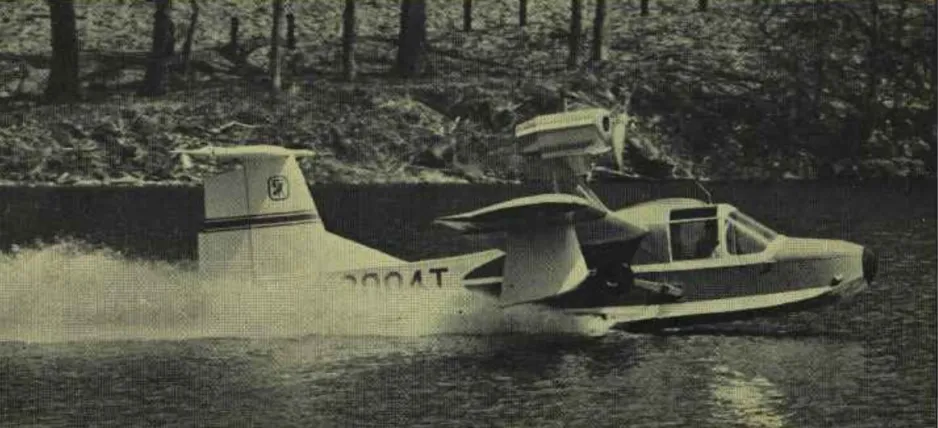
The fourth Thurston Teal, an aircraft operated by Pelham Airways Incorporated of New York City, New York. Anon., “Teal for Two.” Flight International, 28 May 1970, 887.
And no, the saga of the Teal / Marlin was / is just too twisted. American aeronautical engineer David B. Thurston founded Thurston Aircraft Corporation in 1966 to produce the light amphibian he had designed. Small scale production began soon after the first flight. The aircraft proved very successful. Incidentally, one of the first 3 Teals went to a Canadian owner. Would you believe that a Teal flew from the United States to Norway in 1975, with several stops of course?
In the early 1970s, Thurston designed a 4-seat landplane version of his amphibian, the TSC-2 Explorer, in conjunction with the magazine of the American National Aero Club, the bimonthly Aero. The publisher of this publication, Marvin Patchen, a pilot, race car driver and great lover of the Baja peninsula, a region of Mexico, funded the project through Marvin Patchen Incorporated.
Thurston having joined the staff of Schweizer Aircraft Corporation in 1972, the latter took control of the Teal production program. Marvin Patchen, the company, not the person, on the other hand, took control of the Explorer’s production program in order to produce civilian (Explorer) and paramilitary (Observer) versions of this versatile observation aircraft which combined the excellent visibility afforded by a helicopter with the relatively small operating costs of an airplane. A small American company, Aerofab Corporation, manufactured a prototype which flew in October 1972. Marvin Patchen, again the company, not the person, also signed an agreement with Schweizer Aircraft to produce the main elements of series Explorer / Observer. For one reason or other, the aircraft did not find buyers in the United States.
A South African company barely out of its egg, National Dynamics (Proprietary) Limited, acquired the production rights of the Explorer and Observer in May 1975, as well as the one and only prototype. Its management apparently hoped to get orders from civilian operators. As nobody knocked on its door, National Dynamics lent said prototype to the South African Air Force, one of the elements of the South African Defense Force. This armed hand of the abominable racist government which then ran South Africa ultimately chose another aircraft to fulfil its observation missions. Having received no civilian order, National Dynamics put the Explorer aside, but back to our story.
Now that I think about it, an assembly project for an observation aircraft similar to the Explorer / Observer was born in Ontario in the summer of 1986. The Payne Group of Companies, a group of Ontario companies formerly involved in the production program of the Avro CF-105 Arrow, a supersonic bomber interceptor mentioned a few times in our blog / bulletin / thingee since February 2018, created a new subsidiary for this purpose.
Headquartered in Toronto, Ontario, Payne Aviation Industries (Canada) Limited was focused on the assembly of a British single-engine 3-seat observation aircraft. Designed by Edgley Aircraft Limited, the OA 7 Optica was a somewhat unusual looking machine which combined the excellent visibility afforded by a helicopter with the relatively small operating costs of an airplane. A prototype flew in December 1979. Placed in receivership in October 1985, the company was reborn in December under the name of Optica Aviation Industries Limited. It was with this company that the Payne Group of Companies did business.
Payne Aviation Industries (Canada) intended to assemble aircraft imported into Canada with the exception of the first 4. This work would be done in a small new factory, probably located in Barrie, Ontario. Opticas assembled in Canada could eventually include 40% Canadian content.
The Optica Aviation Industries plant unfortunately fell victim to arson in January 1987. The aircraft manufacturer disappeared only to be reborn in February under the name Brooklands Aircraft Company Limited, a subsidiary of Brooklands Aerospace Group Public Limited Company. A subsidiary of the Danish group FLSmidth & Company Aktieselskab, FLS Aerospace Limited, acquired Brooklands Aerospace Group in July 1990. Production of the Optica Scout, a new name adopted around this time, remained stalled, however. Ontario’s Optica assembly project quickly fell into oblivion.
In 2008, the founder of Edgley Aircraft founded AeroElvira Limited and tried to relaunch production of the Optica, without success one must admit. Having conducted an assessment to this effect, an American consulting firm told the small British firm in June 2017 that it wanted to find an aircraft manufacturer to restart the production of the Optica. InterFlight Global Corporation ended its efforts in late June 2018, however. AeroElvira was still hanging on as of 2019. Barely more than 20 Opticas were made between 1979 and 1987 or so.
Where was I? Oh yes, the twisted saga of the Teal. With all your digressions, yes, yes, your digressions, I came to forget the thread of our story.
As the spring of 1976 came to a close, Teal Aircraft Corporation of Buttonville, Ontario, a newly created small company, purchased Teal’s production equipment and the production rights from Schweizer Aircraft. It also obtained 3 incomplete aircraft. The founders of the company, all 3 airline pilots of the national airline, Air Canada, Raymond “Ray” English, Linwood “Lin” Wolfe and Thomas “Tom” Martindale, hoped to produce the standard 2-seat version as well as another, more powerful and with 4 seats, of the Teal, in Buttonville or St. Thomas, Ontario. They actually hoped to leave these temporary premises for a factory located in an industrial park in Centralia, Ontario.
Curiously, the Ministry of Transport told the aircraft manufacturer that the transfer of the Teal production rights to a Canadian company meant that the Federal Aviation Administration (FAA), the agency responsible for civil aviation in the United States, no longer guaranteed the design and airworthiness of the aircraft. This responsibility now belonged to its Canadian counterpart, said Ministry of Transport. The latter, however, refused to accept any responsibility until all the documentation concerning the Teal had been examined.
Indeed, the ministry informed Teal Aircraft in March 1976 that the file review and re-certification could continue until January 1977, or even until May. Alarmed by this decision, Teal Aircraft had no choice but to wait. Worse still, the ministry demanded that some tests be redone on Canadian soil. In October 1976, Teal Aircraft learned that the examination of the file could continue until August 1977, or even until June 1978. Isn’t bureaucracy a wonderful thing?
Staggered by the nightmare that the small Ontarian aircraft manufacturer had to endure, the Minister of Transport, Otto Emil Lang, a gentleman mentioned in an August 2019 issue of our you know what, intervened in the file. He approved the addition of staff assigned to the file review, but no more. Out of patience, the aforementioned Martindale withdrew from the project. A surveyor and private pilot, Donald “Don” McIntosh, took his place. In an effort to raise funds for Teal production, Teal Aircraft sought federal assistance from the Department of Industry, Trade and Commerce through the Program for the Advancement of Industrial Technology. The Teal not being a new aircraft, the loan application was politely rejected.
This being said (typed?), Teal Aircraft’s management was also studying the possibility of establishing a plant in Buffalo, New York, to assemble on American soil the main sub-assemblies of the Teal manufactured by Fleet Industries Limited of Fort Erie, Ontario, a division of Ronyx Corporation Limited mentioned in an April 2019 issue of our blog / bulletin / thingee. If the FAA saw no major objection to such an approach, Teal Aircraft eventually concluded that Buffalo’s winter climate was too severe for the flight tests of a light amphibian like the Teal. Having learned that Fairchild Industries Limited, a subsidiary of the American aircraft manufacturer Fairchild Republic Company, planned to close a plant in Florida, the small Canadian company initiated discussions.
Teal Aircraft quickly realised that moving to the United States would dramatically reduce its operating costs and give it access to a large pool of skilled workers. Better yet, the company would get direct access to the massive American market. The Florida government, meanwhile, was so interested in the coming of Teal Aircraft that its Small Business Administration agreed to guarantee 90 % of a loan that was granted. Teal Aircraft put the key in the door of its Buttonville hangar in March 1977.
Financial problems led to the closure of the Florida plant at an undetermined date. Teal Aircraft had manufactured 7 Marlins, a new name chosen to underline its independence, on American soil. Efforts to revive production under the leadership of a new American company, Advanced Aircraft Incorporated, by 1983-84, went nowhere. Another American company, International Aeromarine Corporation, took on the torch but disappeared in 1991 apparently without making any aircraft. Was this not a twisted saga, my reading friend whose patience was seriously put to the test?
Over the years, Thurston Aircraft, Schweizer Aircraft and Teal Aircraft manufactured less than 40 Teals / Marlins. But now back to our story, and the second interesting project that Falconar Aircraft was working on.
Said project concerned a single-seat single-engine airplane which reproduced, on a 2/3 scale, the silhouette of one of the most famous fighter airplanes of the Second World War, the American North American P-51 Mustang. And yes, it’s the aircraft on the photograph at the very beginning of this article. And yes, there is a Mustang in the prodigious collection of the Canada Aviation and Space Museum.
The individual at the heart of this project was / is a French engineer of Romanian origin. Born in 1921, Marcel Jurca joined the Aeronautica Regala Romana shortly after the start of the Second World War, a conflict during which Romania fought side by side with National Socialist Germany. He served as a pilot in a ground attack unit around 1943-44. Since Romania was for all practical purposes occupied by the Union of Soviet Socialist Republics from 1944 onward, Jurca went to France in 1948. A naturalised citizen of that country in 1965, he worked for a few important companies. Jurca retired in 1983. He died in October 2001, at the age of 80.
The MJ-7 Gnatsum, or Mustang spelled backward, was / is the first Second World War fighter airplane replica designed by Jurca – and one of the first such replicas in the world. Indeed, the latter based his design on the structure of the fuselage of his MJ-5 Sirocco, an excellent homebuilt 2-seater which flew for the first time in August 1962.
The Gnatsum may, I repeat may, have originated from a meeting in 1963 between Falconar and a homebuilder who wished to build a smaller scale replica of a Second World War British fighter airplane, a Hawker Typhoon or Hawker Tempest. Jurca was to provide the plans while Falconar was to raise the funds. The Mustang soon took the place of said British fighter airplane.
Falconar having proposed / requested a fairly large number of changes to the plans he had submitted, Jurca withdrew from the Canadian Gnatsum project. The prototype, built by Norman Easton of Edmonton from a Falconar kit, flew at the end of July 1969, however, at Canadian Forces Base Edmonton, a month after an incident during a high-speed taxi run and 2 or 3 days after its sale to Thermalbird Flying Association of Edmonton. Said incident resulted in modifications to the aircraft.
Incidentally, the Gnatsum’s test pilot, also a homebuilder, Joseph “Joe” Broeders, made a nonstop flight between North America and North Africa, on a 6-seat Piper PA-23 Aztec light / private twin-engine airplane it was said, on an undetermined date.
Thermalbird Flying Association seriously modified the Gnatsum around September 1970 to improve its flying characteristics. It sold the aircraft to an American pilot and mayor of his village (1961-1985), Harry J. Raday, in October 1970. The latter may, I repeat may, have received the Gnatsum in August 1971, at the International EAA Fly-In Convention. Yours truly does not know when this historic aircraft was removed from the American civil aircraft registry.
Falconar Aircraft sold its first set of Gnatsum plans even before the end of 1969.
Convinced that it has found a good vein, the company thought of selling sets of plans of single-engine single-seaters, also designed by Jurca, which reproduced, on a 3/4 scale, the silhouette of 2 other fighter airplanes of the Second World War as famous as the Mustang, the British Supermarine Spitfire and the German Focke-Wulf Fw 190 Würger. If Falconar Aircraft seemed to sell sets of plans of the derivative of the latter, the Jurca MJ-8 1-Nine-0, from the second half of the 1970s onward, it seemingly did not do the same in the case of the Jurca MJ-10, the derivative of the Spitfire.
The use of a 3/4 rather than 2/3 scale was due to the fact that American homebuilders, the main buyers of the sets of plans, apparently found the 2/3 scale replicas a little bit small / narrow.
Yours truly unfortunately does not know if Falconar Aircraft sold sets of plans of single-engine single-seaters, also designed by Jurca, which reproduced, on a 3/4 scale, the silhouette of 2 other famous fighter airplanes of the Second World War, the Jurca MJ-77 Gnatsum, another replica of the aforementioned Mustang, and the Jurca MJ-12, a replica of the Curtiss P-40 Warhawk, an aircraft used by Commonwealth air forces, including the Royal Canadian Air Force (RCAF), under the names Tomahawk / Kittyhawk.
Let’s mention in passing that there is 1 Kittyhawk and 3, yes, yes, 3 Spitfires in the fabulously prodigious collection of the Canada Aviation and Space Museum.
At least 1 500 homebuilders from around the world bought sets of MJ-77, MJ-8, MJ-10 and MJ-12 plans even before the end of the 1990s. Only the Flying Spaghetti Monster knows how many of these projects were completed. Only one of these aircraft was in the Canadian civil aircraft registry as of 2019.
It should be noted that Jurca also designed full-size replicas of famous Second World War fighter airplanes:
- the MJ-80, a replica of the aforementioned Fw 190,
- the MJ-90, a replica of the Messerschmitt Bf / Me 109, and
- the MJ-100, a replica of the aforementioned Spitfire.
The first examples of these fairly expensive aircraft flew outside Canada in 1994 (MJ-100) and 2006 (MJ-80). Jurca was also working on a full size replica of the aforementioned Mustang at the time of his death. The plans of this MJ-70 were not completed.
And yes, you are right, my reading friend, the Canada Aviation and Space Museum’s out-of-this-world collection does include a Bf / Me 109. I am proud of you. And yes, you can have a gold star.
It should be noted that Falconar Aircraft developed a small wind tunnel designed to teach the principles of aerodynamics in schools. The students in the aeronautical program of the M.E. LaZerte Composite High School in Edmonton, today’s M.E. LaZerte High School, received the first (and only?) example of this equipment, christened XFB-D70, in the spring of 1971.
Anxious to pay off debts and provide education for his sons, Falconar sold Falconar Aircraft to a Pacific Western Airlines Limited pilot, George F. “Joe” Chivers, and a few other investors in 1971. Let’s be brutal here. The changes made to the Gnatsum to allow it to fly safely placed Falconar Aircraft virtually on the brink of bankruptcy. The Falconar Aircraft Limited division of Sturgeon Air Limited (SAL) of Edmonton, the company’s new name, ended its operations around the middle of the1970s. Falconar himself left the company in 1973. He founded Falconar Aviation Limited around 1985. The names given over the years to the 2/3 and 3/4 scale replicas of the Mustang, that is Falconar SAL 2/3 Mustang, SAL Mustang, SAL P-51D Mustang, etc., reflected these changes in corporate identity.
An unusual looking 2-seat ultralight flew in Edmonton in August 1986. Designed by Falconar for Alberta Air R.V. Limited between 1984 and 1986, the ARV-1 Golden Hawk was a canard, in other words an aircraft whose elevators were placed at the front. The name of this aerial recreational vehicle (Air RV / ARV) commemorated an RCAF aerobatic team, the Golden Hawks, created in 1959 to commemorate the 50th anniversary of the first sustained and controlled flight of a powered airplane on Canadian soil, made in February 1909 by John Alexander Douglas McCurdy. Alberta Air R.V. sold the Golden Hawk in the form of aircraft capable of flight or kits, in the latter case destined for the American market. The company seemingly disappeared before 1990. It seemed to manufacture only a few (5?) Golden Hawks. Three of them were still flying in 2019.
And yes, my faithful reading friend, McCurdy was mentioned in September 2017 and October 2018 issues of our everlasting blog / bulletin / thingee. And yes again, the speedy mount of the Golden Hawks was the Canadair Sabre jet fighter, a type of aircraft represented in the fabulous collection of the Canada Aviation and Space Museum. Said collection actually includes 2 Sabres, including one flown by the Golden Hawks.
Legal problems and a vandal attack resulted in the closure of Falconar Aviation in 1994. Falconar Avia Limited was established as early as the following year. It still sold kits and sets of plans. Falconar having left this world in September 2018, at the age of 91, his company closed its doors in June 2019.
A very small Torontonian company owned by Pelah Group Proprietary Limited, Manna Aviation, acquired the rights to many aircraft whose plans were sold by Falconar Avia, however. An interesting (and fun?) detail if I may be permitted. The municipality of Toronto mentioned in the previous sentence was / is not in Ontario, but in Australia.
Yours truly dares to hope that this overview of the history of the Gnatsum and of the career of “Chris” Falconar pleased you. See ya later.
I wish to thank all the people who provided information. Any mistake contained in this article is my fault, not theirs.


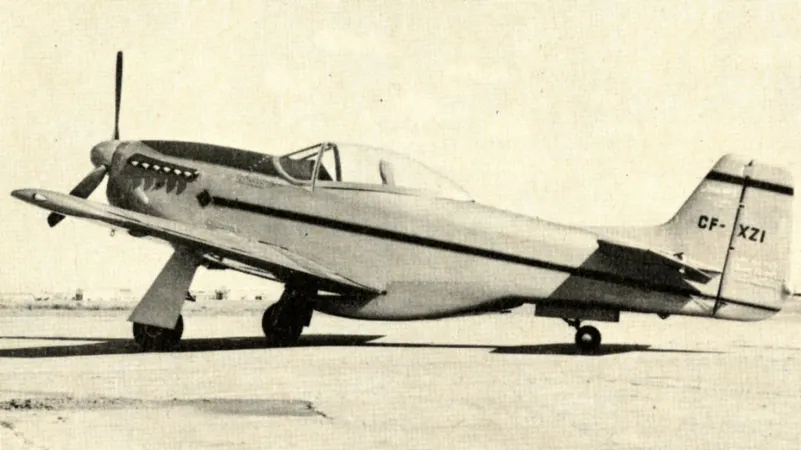












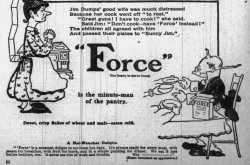
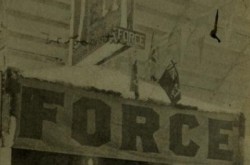
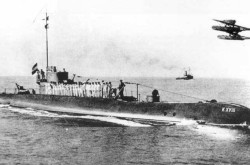
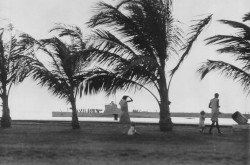
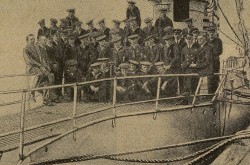
![A block of photographs showing some of the people involved in the bombing of beluga whales in the estuary and gulf of the St. Lawrence River. Anon., “La chasse aux marsouins [sic]. » Le Devoir, 15 August 1929, 6.](/sites/default/files/styles/thumbnail_7/public/2024-09/Le%20Devoir%2015%20aout%201929%20page%206.jpg?h=584f1d27&itok=TppdLItg)
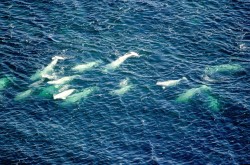
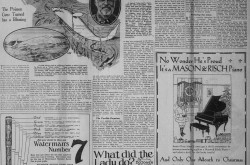
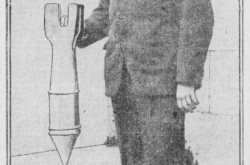
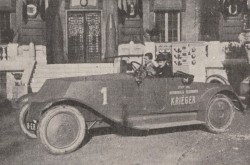
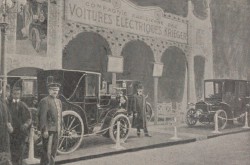
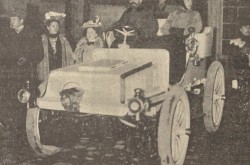
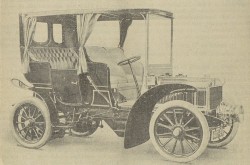

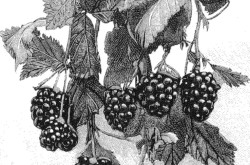
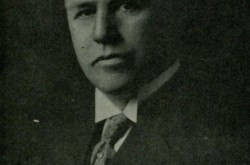
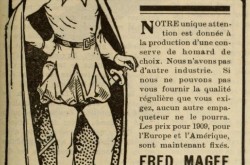
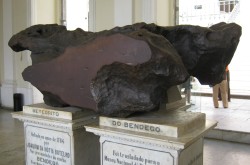
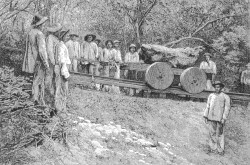
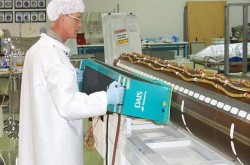
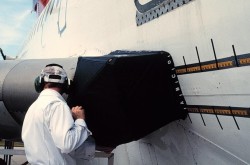
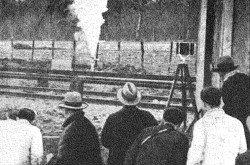
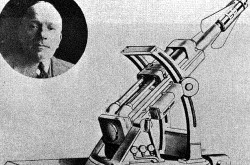
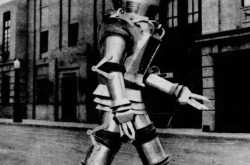

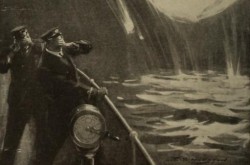
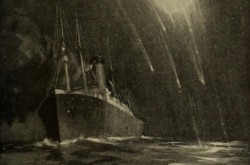
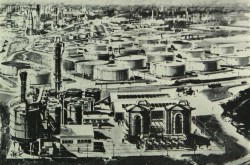
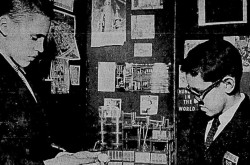
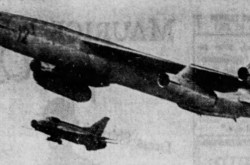
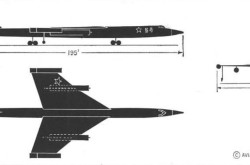
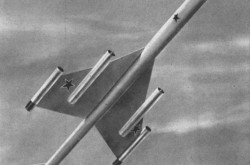
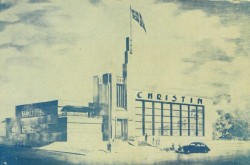
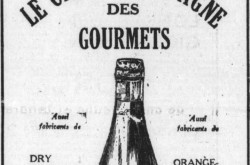
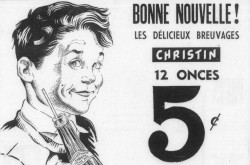
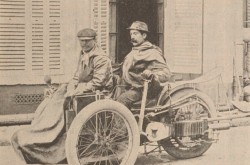
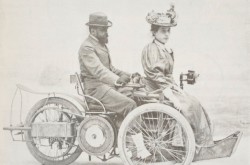
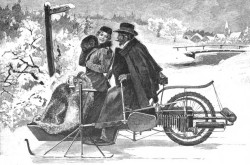
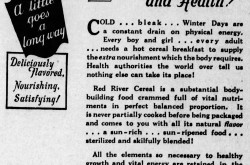
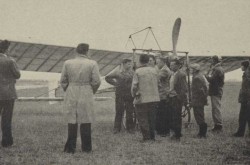
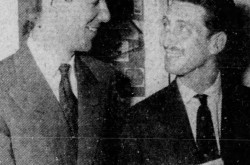
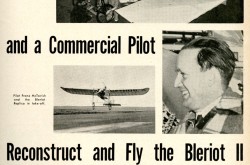
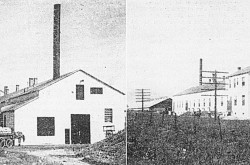
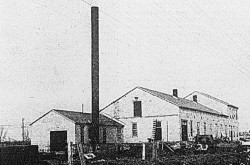
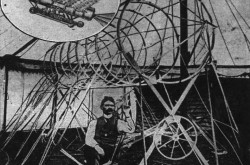
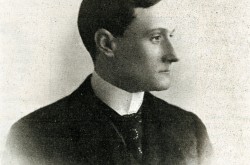
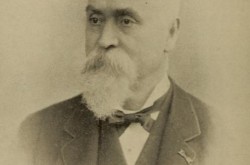
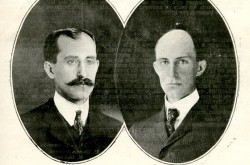
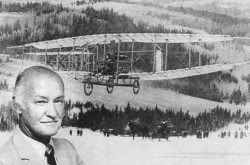
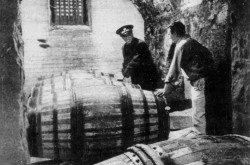
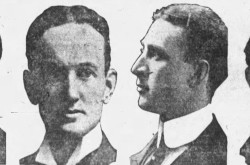
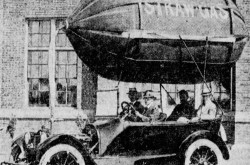
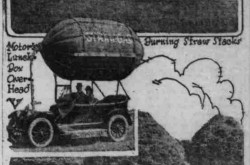
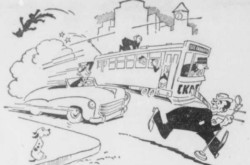
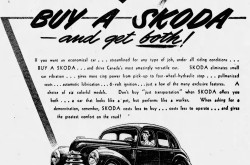
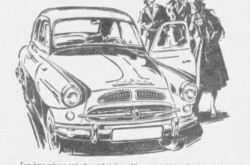
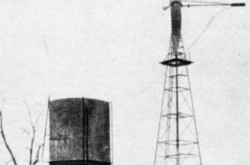
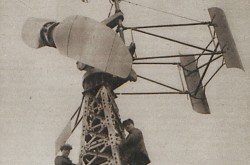
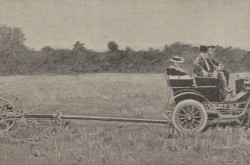
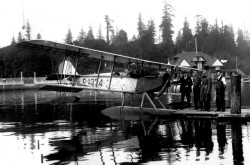
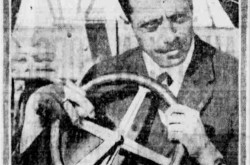
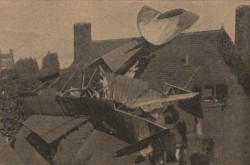
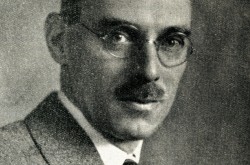
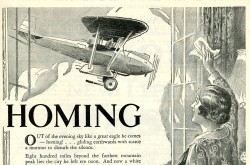
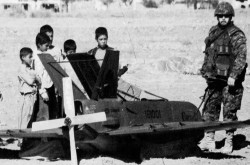
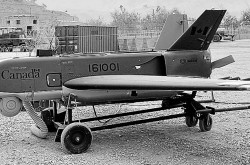
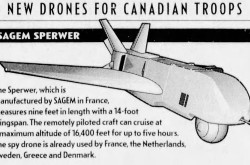
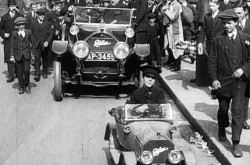

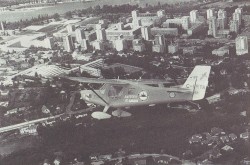
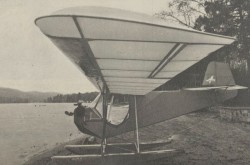
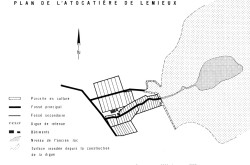
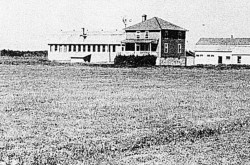
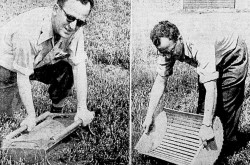

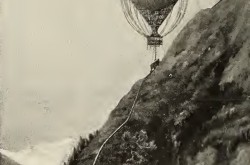
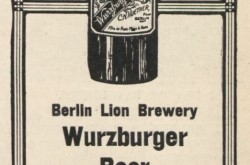
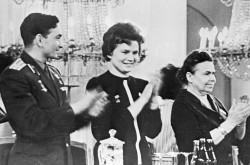
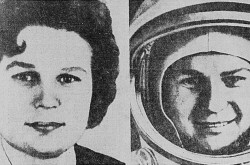
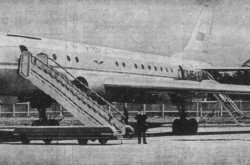
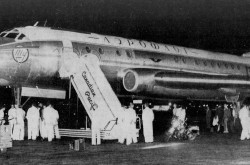
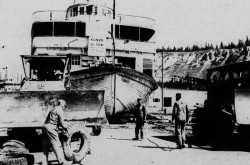
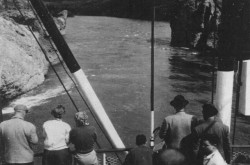
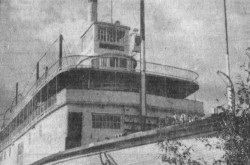
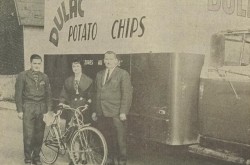
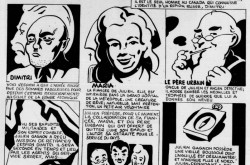
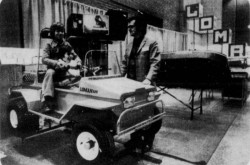
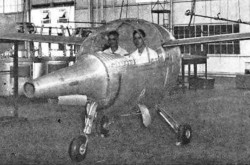
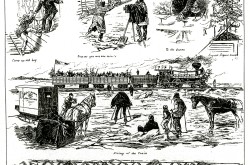
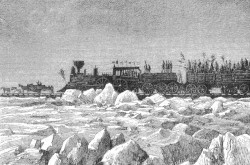
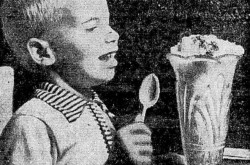
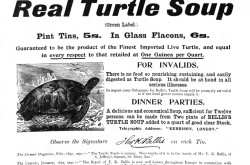
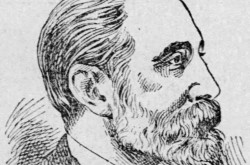
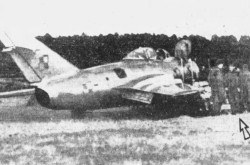
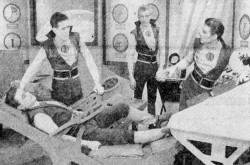
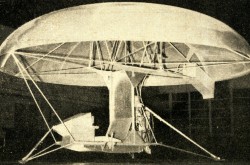
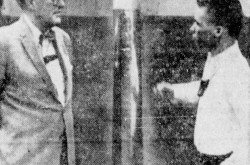
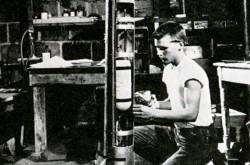
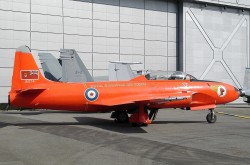
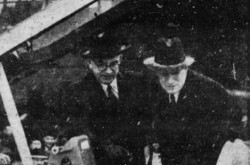
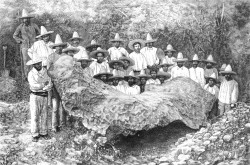
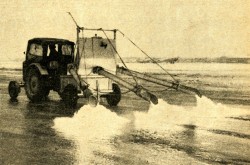
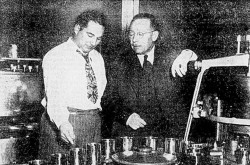
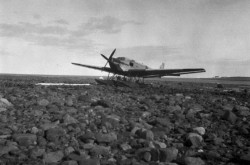
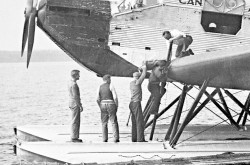
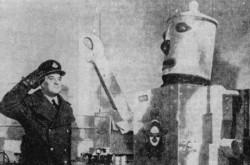
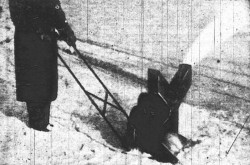
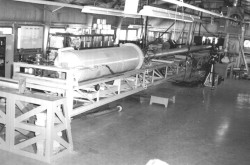
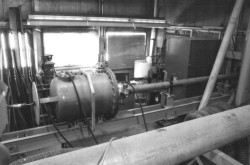
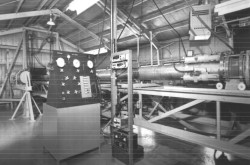
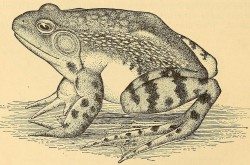
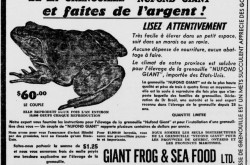
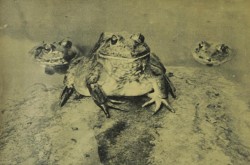
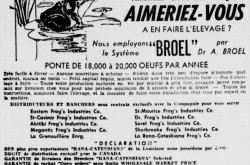
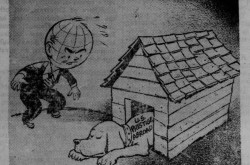
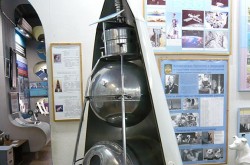
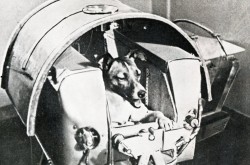
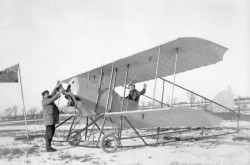
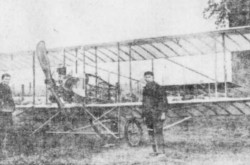
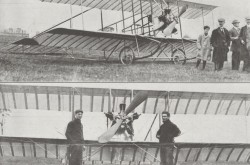
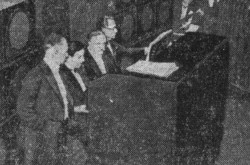

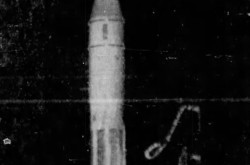
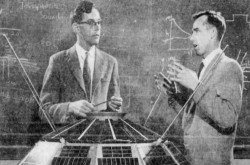
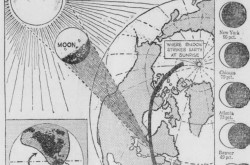
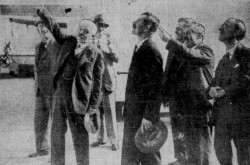
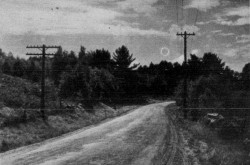

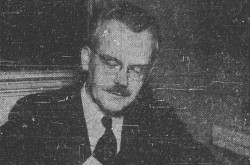
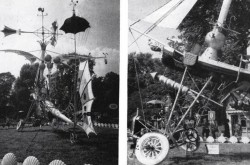
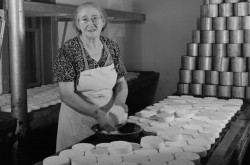
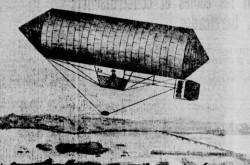
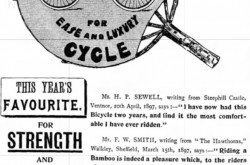
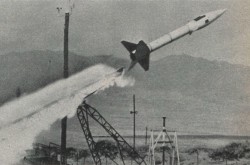
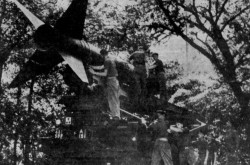
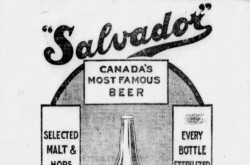
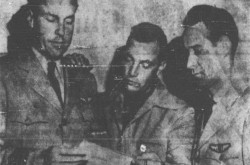
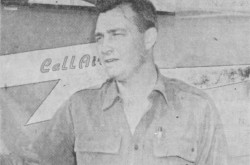
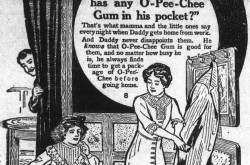
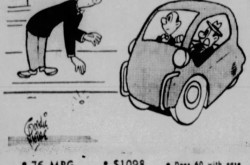
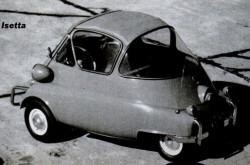
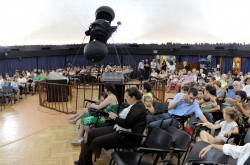
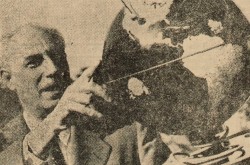
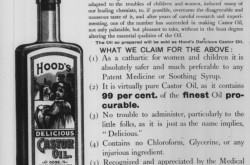
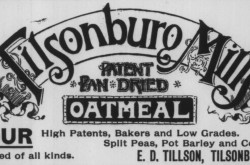
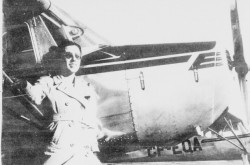
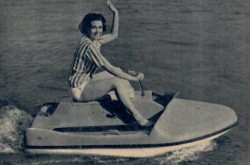

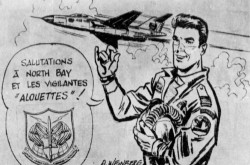
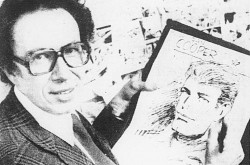
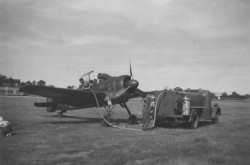
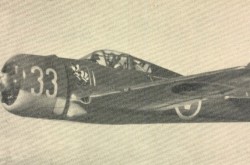
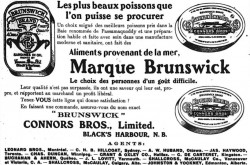
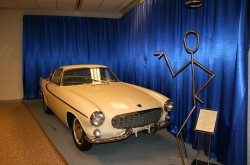
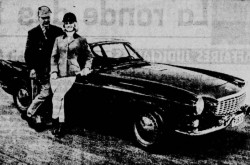
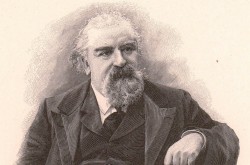
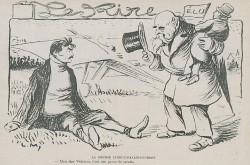
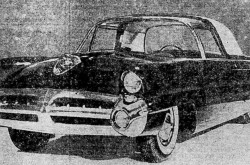
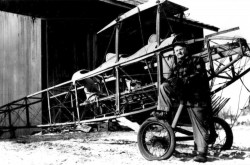
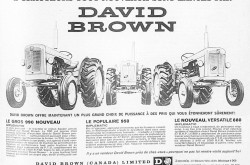
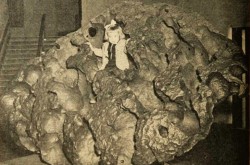
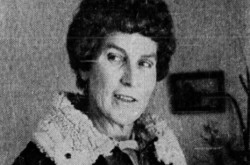
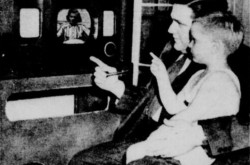
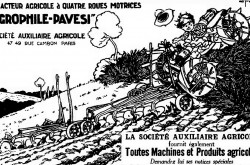
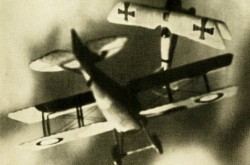
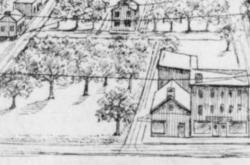
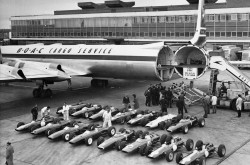
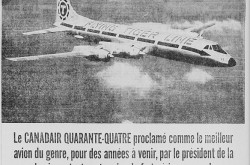
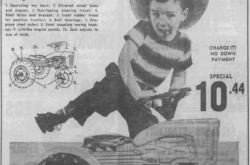
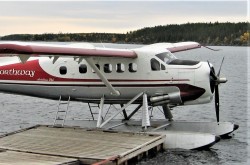
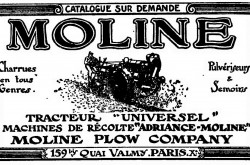
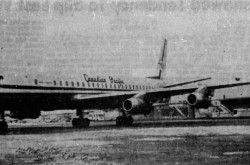
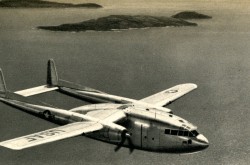
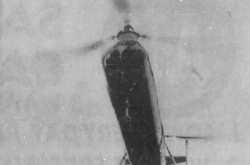
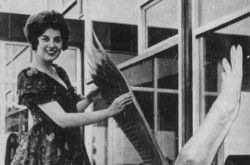
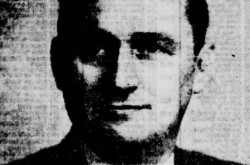
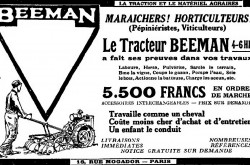
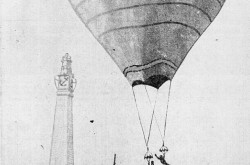
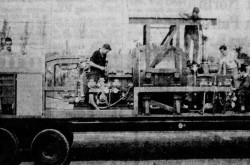
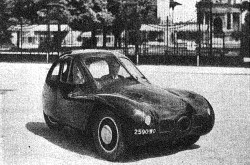
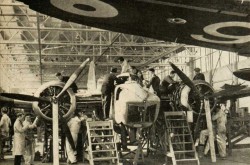
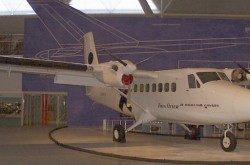
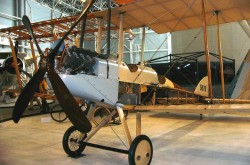
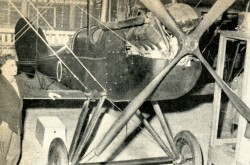
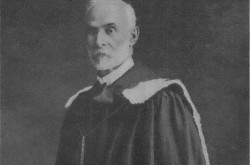
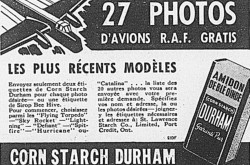
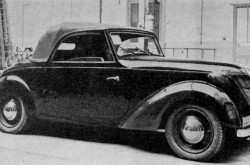
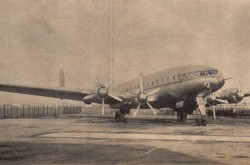
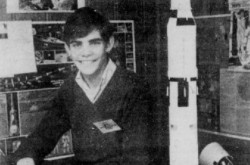
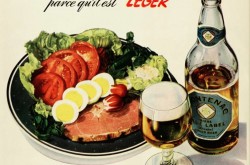
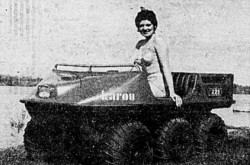

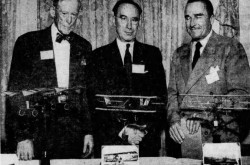
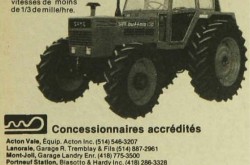
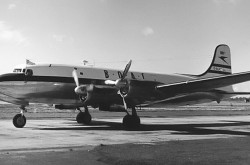
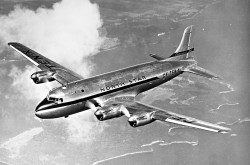
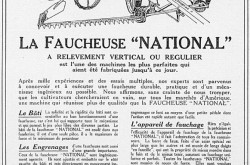
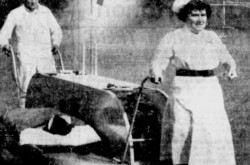
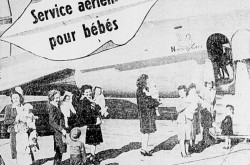
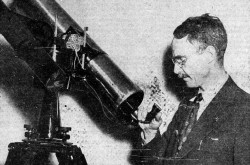
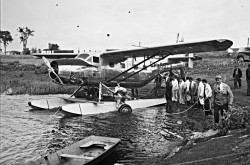
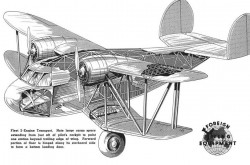
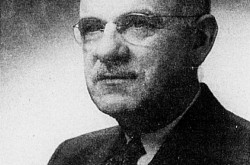
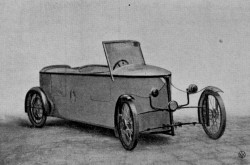
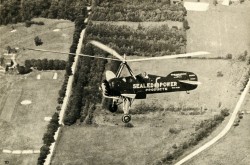
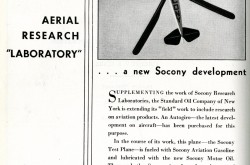
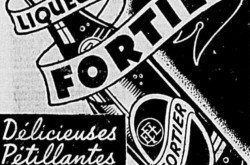
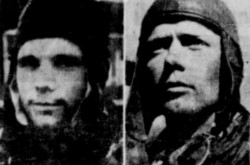
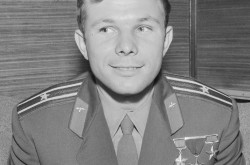
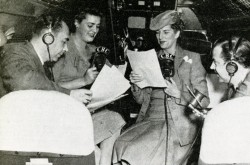
![Peter Müller at the controls [sic] of the Pedroplan, Berlin, Germany, March 1931. Anon., “Cologne contre Marseille – Le mystère du ‘Pédroplan.’ [sic]” Les Ailes, 2 April 1931, 14.](/sites/default/files/styles/thumbnail_7/public/2021-04/Les%20Ailes%202%20avril%201931%20version%20big.jpg?h=eafd0ed4&itok=WnBZ5gMf)
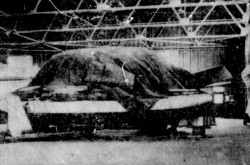
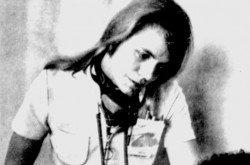
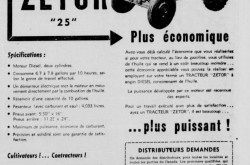
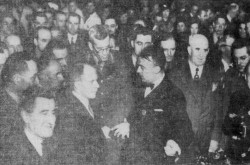
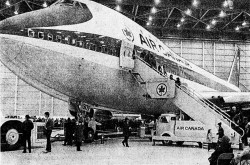
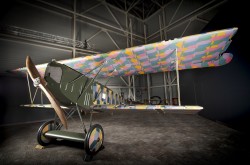
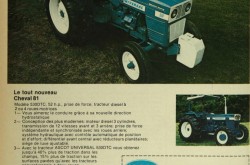
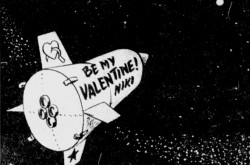
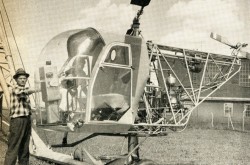
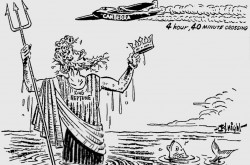
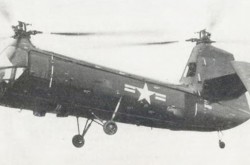
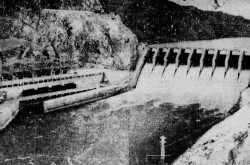
![One of the first de Havilland Canada Chipmunk imported to the United Kingdom. Anon., “De Havilland [Canada] DHC-1 ‘Chipmunk.’” Aviation Magazine, 1 January 1951, cover.](/sites/default/files/styles/thumbnail_7/public/2021-01/Aviation%20magazine%201er%20janvier%201951%20version%202.jpg?h=2f876e0f&itok=DM4JHe5C)
